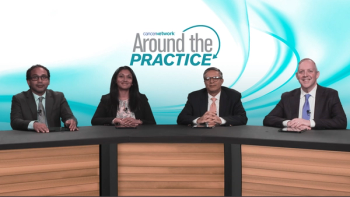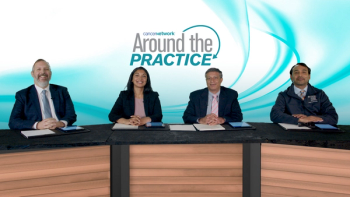Articles by Jonathan Kaufman, MD

Panelists discuss a clinical scenario involving a 56-year-old male man with myeloma and del 17p deletion, treated with RVD induction, auto transplant, and lenalidomide maintenance, who relapsed after 2 years and is now referred to discuss chimeric antigen receptor (CAR) CAR-T versus vs standard therapy, sharing key takeaways and pearls from the case.

Panelists discuss successful collaborations between academic centers and community practices in the context of (chimeric antigen receptor (CAR) T-cell therapy for multiple myeloma, key lessons learned in integrating CAR T therapy into the treatment landscape, and future plans for expanding CAR T therapy’s role in earlier lines of multiple myeloma treatment.

Panelists discuss their institution’s approach to co-management and co-monitoring of (chimeric antigen receptor (CAR) -T patients, strategies to facilitate seamless transitions of care between academic centers and community practices, common challenges in the CAR -T referral process and solutions, and advice for community physicians on the timing and preparation for patient referrals.

Panelists explain how CAR-T cell therapy works and describe the treatment process, discussing whether CAR -T is considered a complex procedure at their institution or if the logistics have been streamlined into clinical workflows, and they also detail their institution's approach to bridging therapy for patients awaiting CAR-T manufacturing and infusion, including whether patients are managed in-house or sent back to community centers.

Panelists discuss which patients are considered for CAR-T therapy in second-line treatment for relapsed/refractory multiple myeloma (R/R MM) (cilta-cel vs ide-cel), describe the specific criteria and institutional guidelines used to determine patient eligibility, and explore how non-medical factors like such as location and financial considerations impact patient selection, while also outlining the typical CAR-T referral process from community physician outreach to patient evaluation and selection.

Panelists discuss the key factors that influence their institution's decision to utilize CAR-T therapy in earlier lines of treatment for relapsed/refractory multiple myeloma and explain the next steps they would take if choosing CAR-T, including the rationale behind their decisions.

Panelists discuss the data surrounding the use of CAR-T therapy in earlier lines of treatment for relapsed/refractory multiple myeloma (R/R MM), including findings from the cilta-cel (Popat R, et al. ASH 2024 No. 1032; Mateos MV, et al. IMS 2024 No. OA-65), and Idel-cel (Ailawadhi S, et al. Blood 2024) studies, and share their thoughts on the implications of these results.

Subject matter experts share strategies for determining treatment selection and duration for patients with transplant-ineligible NDMM.

Subject matter experts share strategies for determining treatment selection and duration for patients with transplant-ineligible NDMM.

Ajay Nooka, MD, MPH, FACP leads a survey of the MAIA study, including a sub-group analysis of the MAIA study in frail patients, as well as findings from the MagnetisMM-6 study.

Jonathan Kaufman, MD describes a second patient case featuring a 76-year-old female diagnosed with transplant-ineligible NDMM.

Defining transplant eligibility, explaining the role of transplant in NDMM, and differentiating between high- and low-risk MM.

Thoughtful discussion centered around recently presented updates to the GRIFFIN, MASTER, and GMMG-CONCEPT studies in NDMM patients.

Nisha Joseph, MD leads an introduction to induction regimen options for patients with transplant-eligible NDMM.

Moderator Sagar Lonial, MD, FACP, and colleagues engage with the first patient case: a 65-year-old female diagnosed with transplant-eligible NDMM.




